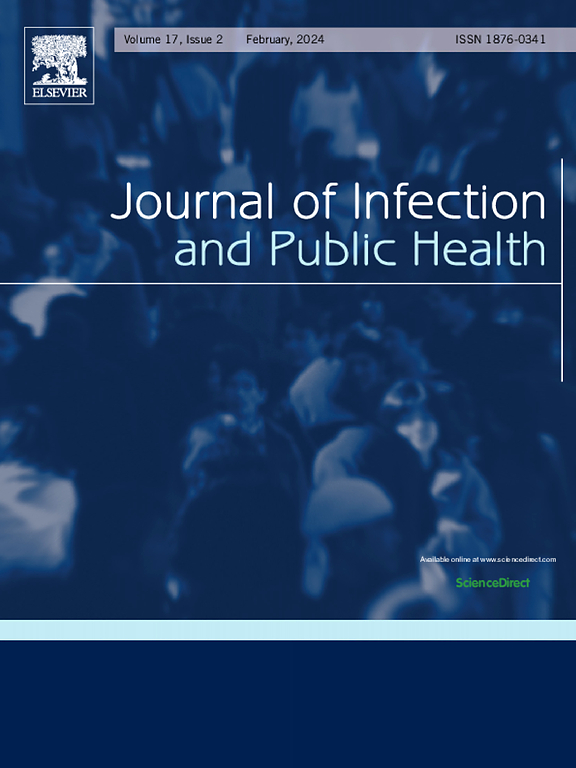北德克萨斯州非结核分枝杆菌的流行和物种多样性
IF 4
3区 医学
Q1 INFECTIOUS DISEASES
引用次数: 0
摘要
背景非结核分枝杆菌(NTM)感染是一种新兴的机会致病菌,类似于结核病(TB)感染,具有广泛的毒力谱。NTM疾病病原体的多样性强调了快速识别的必要性,因为它因地理区域而异,治疗方法也各不相同。本研究旨在确定非结核分枝杆菌在北德克萨斯州恢复的患病率。方法于2022年1月1日至2023年12月31日进行回顾性研究。我们将15724份肺和肺外标本提交抗酸杆菌(AFB)培养。共有820个分枝杆菌生长标本进行最终分析。在我们的站点评估了物种流行率、生长地点和季节趋势。结果15724份AFB培养标本(5.21 %,n = 820)检出分枝杆菌24种/亚种。总体而言,NTM患病率为(5.05 %,n = 795)。820例患者中,NTM的发病率为(97 %,n = 795),结核分枝杆菌的发病率为(3 %,n = 25)。肺标本分离NTM 15.4 %(704/4574),肺外标本分离NTM 0.82 %(91/ 11150)。(63 %,n = 514)为生长缓慢的分枝杆菌。主要的特种加工物种m . avium复杂(MAC)(46 % n = 375),其次是m .脓肿复杂(23.78 % n = 195),m . chelonae(4.9 % n = 40),m . mucogenicum phocaicum(3.9 % n = 32),和m . arupense(2.1 % n = 17)。值得注意的是,MAC在7月和2月出现周期性低点,但在10月达到峰值。脓肿分枝杆菌复合体无季节分布规律。结论NTM的发病频率明显高于TB。值得注意的是,禽分枝杆菌复合体和脓肿分枝杆菌复合体的流行率居首位,而新出现的chelonae和mucogenicum phocaicum。这需要一种精确的分析方法,以确定NTM的不同地理分布和采取控制措施所需的特定物种治疗方案。本文章由计算机程序翻译,如有差异,请以英文原文为准。
Prevalence and species diversity of non-tuberculous mycobacteria in North Texas
Background
Non-tuberculous mycobacterial (NTM) infections are an emerging group of related opportunistic pathogens resembling tuberculosis (TB) infections with a wide virulence spectrum. The diversity of the causative agents of NTM disease underscores the need for swift identification, as it differs by geographic regions, and treatment approaches vary. This study aimed to determine the prevalence of Non-tuberculous Mycobacteria recovered in North Texas.
Methods
A retrospective study was conducted between January 1, 2022, to December 31, 2023. We included 15,724 pulmonary and extra-pulmonary specimens submitted to Acid Fast Bacilli (AFB) culture. A total of 820 specimens growing with the Mycobacterial species were counted for the final analysis. Species prevalence, site of growth, and seasonal trends were evaluated at our site.
Results
In a total of 15,724 AFB cultures (5.21 %, n = 820), specimens were positive for twenty-four different species/subspecies of mycobacteria. Overall, the prevalence of NTM was (5.05 %, n = 795). Out of 820, the incidence of NTM was (97 %, n = 795) and M. tuberculosis complex (3 %, n = 25). 15.4 % (704/4574) of NTM were isolated from pulmonary and 0.82 % (91/11,150) from extra-pulmonary specimens. (63 %, n = 514) were slow-growing mycobacteria. The major NTM species were M. avium complex (MAC) (46 %, n = 375), followed by M. abscessus complex (23.78 %, n = 195), M. chelonae (4.9 %, n = 40), M. mucogenicum phocaicum (3.9 %, n = 32), and M. arupense (2.1 %, n = 17). Notably, MAC had cyclical low points in July and February but peaked in October. There was no seasonal pattern for M. abscessus complex.
Conclusions
Our findings revealed that the frequency of NTM was much higher than TB. Remarkably, the prevalence of M. avium complex and M. abscessus complex occupies the top rank, with the emerging M. chelonae and M. mucogenicum phocaicum. This warrants a precise analytical approach to identify the NTM as the diverse geographical distribution and the needed species-specific treatment regimen to adopt control measures.
求助全文
通过发布文献求助,成功后即可免费获取论文全文。
去求助
来源期刊

Journal of Infection and Public Health
PUBLIC, ENVIRONMENTAL & OCCUPATIONAL HEALTH -INFECTIOUS DISEASES
CiteScore
13.10
自引率
1.50%
发文量
203
审稿时长
96 days
期刊介绍:
The Journal of Infection and Public Health, first official journal of the Saudi Arabian Ministry of National Guard Health Affairs, King Saud Bin Abdulaziz University for Health Sciences and the Saudi Association for Public Health, aims to be the foremost scientific, peer-reviewed journal encompassing infection prevention and control, microbiology, infectious diseases, public health and the application of healthcare epidemiology to the evaluation of health outcomes. The point of view of the journal is that infection and public health are closely intertwined and that advances in one area will have positive consequences on the other.
The journal will be useful to all health professionals who are partners in the management of patients with communicable diseases, keeping them up to date. The journal is proud to have an international and diverse editorial board that will assist and facilitate the publication of articles that reflect a global view on infection control and public health, as well as emphasizing our focus on supporting the needs of public health practitioners.
It is our aim to improve healthcare by reducing risk of infection and related adverse outcomes by critical review, selection, and dissemination of new and relevant information in the field of infection control, public health and infectious diseases in all healthcare settings and the community.
 求助内容:
求助内容: 应助结果提醒方式:
应助结果提醒方式:


